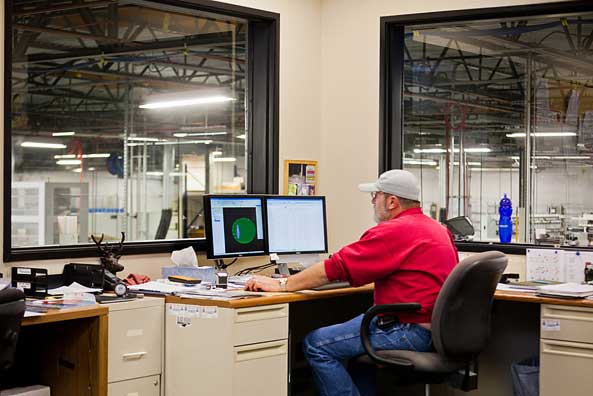Learn About Computer Aided Drafting (CAD) and Computer Aided Manufacturing (CAM)

Computer Aided Drafting (CAD) and Computer Aided Manufacturing (CAM) are now an integral part of manufacturing processes all over the world. At API/AMS, your leader in CNC machining in Portland and the surrounding areas, we are proud to offer these two tools to help our customers achieve their needs. We provide everything from design services and solid modeling, to programming, drafting and file conversion.
CAD History and Uses
CAD is used primarily to make 3D models or 2D drawings of anything we are asked to make. CAD creates complex computer models with geometrical parameters, and by tweaking or altering those parameters, we can both test and view what could be possible with these designs. CAD originated in the car industry in the early 1960s at General Motors, and marked a dramatic shift away from the time consuming and lengthy process of drafting by hand. This shift to computers also meant that the design could be adjusted with a few keystrokes instead of redoing entire schematics. In the aerospace and semiconductor industries, use of CAD also found widespread treatment to test out products without going through a lengthy design and build cycle. In the later 1960s, CAD was found to be extremely useful in the movement from design to manufacturing, and using numerical control machines, like CNC, to achieve consistent and efficient manufacturing processes.
The Rise of PCs Leads to Widespread Adoption
This shortened time between design and manufacturing and the linking of the same systems that CAD and CAM used with their geometrical 2D and 3D data, is what led the ongoing success of CAD and CAM. It mean that automated processes using machinery could be expanded easily and cheaply as well as resulting in more control over all of the process including production and manufacturing. By the time the 1970s rolled around and the semiconductor industry really took off, the CAD/CAM technology was about to get its biggest boost as computers became cheaper, more powerful, and more readily available. This meant that small and medium sized industries and companies could now adopt these CAD and CAM techniques, which before had been used primarily by larger corporations.
How API/AMS uses CAD and CAM
CAD/CAM systems have enabled API/AMS to focus on flexibility and precision for all our clients. By using Mastercam (the most widely used CAM software worldwide), our staff of highly trained experts can deliver the best possible techniques for whatever the needs might be. We also use SolidWorks, TekSoft CAD/CAM, and Sigmanest to provide our customers with the very best in design and programming. We offer the ability to take your vision from concept to production in a short amount of time, and extreme flexibility. Our staff receives ongoing training, and we adhere to the latest software upgrades to streamline the design and manufacturing processes.
In-House Tooling and Creating Go/No Go Text Fixtures
Since our programming department also handles our “in-house tooling” and fixturing, we can drastically reduce run times and increase accuracy and quality. We also can design welding fixtures to allow larger production and use our quality control process to easily create “Go/No-Go” test fixtures that quickly determine the accuracy of a part at a specific stage of production. All of these practices we have adopted means savings in materials and time for our clients.
Contact us today to learn more about how we can help with your CAD/CAM and manufacturing needs.
